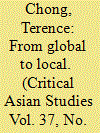|
|
|
Sort Order |
|
|
|
Items / Page
|
|
|
|
|
|
|
| Srl | Item |
| 1 |
ID:
071011


|
|
|
|
|
| Publication |
2005.
|
| Summary/Abstract |
A number of recent works have focused on the personal experiences of kamikaze pilots, but very little has been published in English on the Japanese government's effort to "kamikazefy" the civilian population in the final year of the Asian PacificWar (1937-45). To illustrate this effort, this article employs images taken from the author's personal collection of over 2,500 Japanese wartime publications (predominantly periodicals). In early 1945, the Japanese government announced a "fight to the death for the home islands," in which civilian "home-front warriors" would fight alongside troops in the event of an Allied invasion. Civilian combatants were expected to follow the "no surrender" policy hammered into Japanese servicemen and to emulate the kamikaze pilots' spirit of supreme sacrifice. The article begins with a brief discussion of the ideology behind kamikazefication, inviting comparisons with suicide missions in other times and places. Historical context is further established by an overview of media accounts of Japanese suicide missions in the Asian PacificWar, beginning with the mission carried out at Pearl Harbor on 7 December 1941. An analysis of media reportage shows how members of suicide missions were glorified and made into role models for all Japanese, even women and children. Servicemen who died for their country were enshrined at the Yasukuni Shrine in Tokyo. The article concludes by suggesting reasons why civilians, even those who died fighting in the war, have not been similarly honored.
|
|
|
|
|
|
|
|
|
|
|
|
|
|
|
|
| 2 |
ID:
071012


|
|
|
|
|
| Publication |
2005.
|
| Summary/Abstract |
From the editors: In 2005 Monthly Review Press (New York) published a book entitled China and Socialism: Market Reforms and Class Struggle, written by Martin Hart-Landsberg (a coeditor of Critical Asian Studies) and Paul Burkett. (The content of the book had appeared earlier, in the July-August 2004 issue of Monthly Review [vol. 56, no. 3].) We invited the editors of Critical Asian Studies to participate in a roundtable discussion of the issues that Hart-Landsberg and Burkett have raised. Responses from CAS editors Victor Lippit, Gene Cooper, Alvin So, Mobo C.F. Gao, and Tai-lok Lui appear in the September 2005 issue of the journal (vol. 37, no. 3). A rejoinder by Hart-Landsberg and Burkett is presented here.
|
|
|
|
|
|
|
|
|
|
|
|
|
|
|
|
| 3 |
ID:
071010


|
|
|
|
|
| Publication |
2005.
|
| Summary/Abstract |
This article explores the effects of Singapore's Global City for the Arts project on the local theater industry. It begins by describing the character of the Singapore state and its ability to meet the challenges of globalization. It then shows that while historically global in orientation, the city-state's early cultural policies were resolutely local and insular prior to the economic recession in 1985. From that year on, local arts and culture was driven by an economic rationale - eventually culminating in the birth of a globally oriented national cultural policy: the Global City for the Arts project. The author contends that the Global City for the Arts project has pressured the Singapore state into shedding some of its authoritarian practices in order to conform to international norms. However, the author also illustrates how certain theater companies with the requisite cultural capital for the Global City for the Arts project have benefited from the country's cultural policies while others that do not possess such cultural capital are marginalized. The article concludes by arguing that the Singapore state, in going global, exacerbates the economic disparity by accentuating preexisting inequalities and divisions in the local.
|
|
|
|
|
|
|
|
|
|
|
|
|
|
|
|
| 4 |
ID:
071009


|
|
|
|
|
| Publication |
2005.
|
| Summary/Abstract |
This article argues that the establishment of the Ministry of Culture in Thailand needs to be understood in a broadly historical perspective that relates to the role of culture in hegemonic strategies of the state. It presents an overview of broadly defined culture policy in Thailand from the 1930s before moving to a more detailed discussion of the period from the 1980s to the present. The principle contention, developed in the second half of the article, is that the current policies of Thailand's Ministry of Culture, and its role in hegemonic identity production, can only be understood by taking account of the variety of factors that shaped the Ministry's emergence. These factors include the influence of international development agencies, strategies of appropriation by the Thai state, and the role of progressive forces within Thailand that seek political and cultural reform. The circumstances under which the Ministry was formed have made it a site of contestation between conservative royalist-nationalist perspectives on Thai national identity and progressive localist and international understandings of Thai national identity.
|
|
|
|
|
|
|
|
|
|
|
|
|
|
|
|
|
|
|
|
|